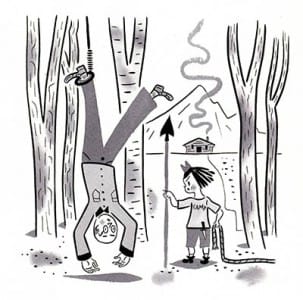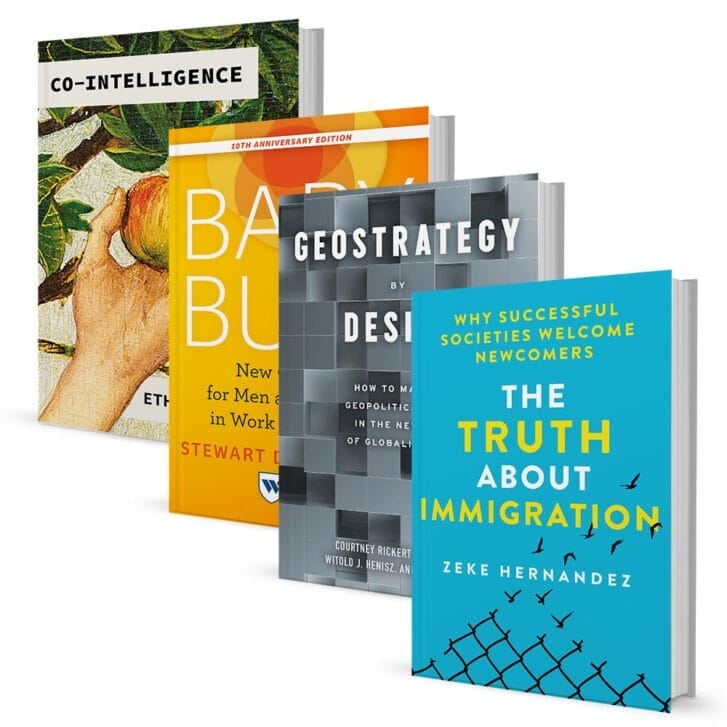Wharton Magazine hired illustrator Michael S. Klein, W ’82, to complete two pieces of art for the recently released Winter 2013 issue. (See “Pricing Mango Madness” and “Teachers Take Over Campus for First-Ever Seminar.”) And while we were at it, we figured we would catch up with Klein, discover how his career has progressed, and discuss his views on how the pursuit of business and art commingle. What follows is a transcript of the conversation.

Michael S. Klein, W ’82
Wharton Magazine: How did you go from Wharton to the world of art?
Michael S. Klein: It happened quite naturally. I graduated from Wharton with a B.S. in economics and a concentration in marketing. In addition to my business studies, I satisfied my interest in the visual arts by taking a full complement of studio art classes in the Fine Arts Department of the College of Arts & Sciences.
These two educational tracks were always interconnected in my own view of the world. In my business classes, I learned to find order in the economic world, and in my painting classes, I did the same thing with the visual world. The urge to distill and organize was the common thread. Fortunately, I was able to pursue both interests at Penn, although I had no idea exactly how I would combine them in a professional career.
WM: Did it lead to your current career right after graduation?
MSK: After graduation, I decided to look for a job on Madison Avenue. The advertising industry seemed like the perfect place to blend my interests in art and business. I landed an entry-level spot as a media planner at Benton & Bowles Advertising (B&B). While the work was not all that creative, B&B had a renowned media department, and it provided me with invaluable exposure to the print industry. I did not realize it at the time, but magazines and newspapers would provide my illustration business with a solid client base in the years to come.
WM: It was soon after, though, that you went out on your own as a freelance illustrator, right?
MSK: At some point, I became aware of the creative field known as illustration. I knew that Illustrators created images for publications and tended to work independently as freelancers. I liked the idea of drawing pictures for a living and running my own business. It seemed like a perfect fit. After two years at B&B, I decided that the first step was to enroll in Parsons School of Design to study illustration. My goals were to supplement my Penn education with some additional, specialized art classes, develop a portfolio and start to build a professional network. After one year at Parsons, I got my first assignment with The New York Times Book Review. I met with the art director on a Friday afternoon. He gave me a book review to illustrate and told me to return on Monday morning with a finished illustration. If it was good enough, it would be published in the next Sunday edition of The New York Times. It was accepted that Monday morning and my career was launched.
WM: And it’s been happily ever after?

Work Klein did for The New York Times
MSK: In the years since that first assignment, I have completed well more than 2,000 illustration assignments. Most of my work has been for editorial clients, supplemented by a wide variety of institutional clients, book publishers, corporations and graphic design firms. Over the years, I have had my work published in many leading magazines, including Time, Newsweek, The New York Times, New York Magazine, Wall Street Journal and Forbes. Other clients have included Chronicle Books, Coca-Cola, Oracle and Microsoft. Even more gratifying, my work has been recognized by my peers with awards from The Society of Illustrators, American Illustration and The Society of Publication Designers.
That said, the print media have faced tremendous challenges in recent years, and that has forced me to re-evaluate my existing business model. At the moment, the path forward is a little unclear, but as an artist, the prospect of change is very exciting.
WM: How would you describe your illustration style?
MSK: Early in my career, I established a witty, graphically clean style that could be applied to a wide range of subject matter. I drew some of my inspiration from the old children’s books, newspaper comics and printed ephemera that I had always loved. My style particularly appealed to art directors who were working with complicated, sometimes dry material. I could satisfy the most literal editors with a smart, clever solution while providing the art directors with the visual charm and graphic sophistication that they wanted on the pages of their publications.
WM: What are some of the aspects of the work that you enjoy best?
MSK: Editorial assignments have typically offered a great deal of creative freedom including the opportunity to continuously explore my own evolving artistic interests. I love the challenge of trying to find a way to solve tough problems with clever, unexpected solutions using my own personal, graphic voice. The challenge is made all the more enjoyable by the parameters and constraints that come with each assignment.
WM: Does your Wharton education still come in handy?
MSK: To put it in the terminology of my economics classes, I think an illustration assignment is a type of constrained optimization problem. Within the fixed parameters of the assignment, I am free to explore my own creativity and artistic ambitions.

Additional work by Klein
MSK: In recent years, I have become involved in teaching young illustrators at the college level. As an adjunct professor at Queens College, I was asked to develop and teach classes in Illustration. I also worked as a curriculum consultant at the New England School of Art & Design, Suffolk University in Boston, where I was asked to develop the framework for a new major program in Illustration As a teacher, my goal is to sharpen my students’ problem-solving skills and help them to develop greater visual literacy.
WM: Perhaps you could add a little more detail to how your Wharton education still comes into play in your career?
MSK: People in the creative world are always surprised, even startled, to learn that I went to Wharton. They inevitably wonder why I am not a banker or a brand manager. In the broadest sense, my Wharton education provided a platform to tackle whatever challenges I face as an artist-businessman. The biggest challenge of course, is finding and cultivating a commercially viable market for my own personal artistic expression. In a narrower sense, my Wharton background probably made me a little better at the nuts and bolts of running a business than some of my peers. I have always enjoyed negotiating the terms of my contracts and looking for new ways to leverage copyright ownership to increase the return on my work.
WM: As someone who has been successful at being self-employed, what lessons of entrepreneurship have you learned?
MSK: Whenever possible, always try to exceed expectations and do everything you can to ensure that your customers come back for more. Keep them surprised and entertained. One of the great things about creating an editorial illustration for a prominent publication is that a job well done will be a job well publicized. So your network is self-cultivating. The biggest challenge of being self-employed is the lack of structure. And I think that it is even more challenging when you are producing a creative work product.
WM: And what do you like most about being a freelancer/self-employed?
MSK: That’s easy. Having the freedom to work at home and spend time with my family.
WM: What advice do you have to current Wharton students who have an artistic streak/ambition?
MSK: Art and business are not irreconcilable pursuits. Cultivate your interests in both art and business. Each will inform the other in surprising and unexpected ways. In today’s business world, where innovation and creativity is highly prized, your artistic streak may provide the springboard needed to make a truly inspirational leap.
Editor’s note: View more artwork at Michael S. Klein’s website. Or view the two illustrations he recently completed for our Winter 2013 issue: “Pricing Mango Madness” and “Teachers Take Over Campus for First-Ever Seminar.”
For profiles of additional Whartonites involved in the arts, read “Portrait of Our Artists” from our Winter 2013 issue.


























